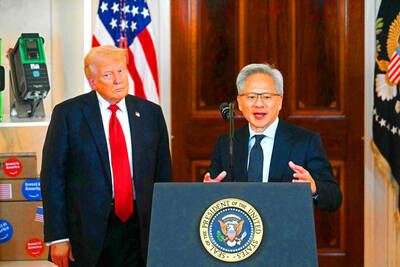Loans to nations targeted by the government’s New Southbound Policy totaled NT$1.18 trillion (US$42.23 billion) as of the end of last month, down NT$9.76 billion from the end of last year, as banks reduced lending due to economic uncertainty amid the COVID-19 pandemic, the Financial Supervisory Commission (FSC) said yesterday.
Combined loans to the 18 nations at the end of last year were NT$1.19 trillion, the commission said.
“That came in contrary to our expectations of a 5 percent increase in banks’ combined loans to Southeast Asia this year,” Banking Bureau Deputy Director-General Lin Chih-chi (林志吉) told a videoconference in New Taipei City.
The decline in lending also came after a string of overseas loans turned sour last year, but Lin said that the commission had not yet concluded that was a contributing factor.
In the first half of this year, loans to India dipped the steepest by 21.4 percent from the end of last year to NT$111.5 billion, while loans to Indonesia decreased 17.4 percent to NT$115.1 billion and those to Singapore fell 12 percent to NT$177.9 billion, FSC data showed.
Australia continued to be the largest market for overseas lending, but loans to the country also fell 1.6 percent to NT$259.8 billion, data showed.
Vietnam was the only market that saw loan growth, with combined lending expanding 20.9 percent to NT$257.6 billion over the period, as more Taiwanese companies increased investments or production in the country and thus needed more funding from banks, Lin said.
Taiwanese banks also have the most units — branches, offices or subsidiaries — in Vietnam, at 58, among the New Southbound Policy countries, he said, adding that the more units a bank has, the more business opportunities it attracts.
Banks have 54 units in Cambodia, 17 in the Philippines and 15 in Myanmar, he said.
The FSC has approved seven banks to set up new branches in Vietnam, while most of them intended to open units in the capital, Hanoi, but have not yet received permission from Vietnamese regulators, Lin said.

Taiwan Semiconductor Manufacturing Co (TSMC, 台積電) last week recorded an increase in the number of shareholders to the highest in almost eight months, despite its share price falling 3.38 percent from the previous week, Taiwan Stock Exchange data released on Saturday showed. As of Friday, TSMC had 1.88 million shareholders, the most since the week of April 25 and an increase of 31,870 from the previous week, the data showed. The number of shareholders jumped despite a drop of NT$50 (US$1.59), or 3.38 percent, in TSMC’s share price from a week earlier to NT$1,430, as investors took profits from their earlier gains

AI TALENT: No financial details were released about the deal, in which top Groq executives, including its CEO, would join Nvidia to help advance the technology Nvidia Corp has agreed to a licensing deal with artificial intelligence (AI) start-up Groq, furthering its investments in companies connected to the AI boom and gaining the right to add a new type of technology to its products. The world’s largest publicly traded company has paid for the right to use Groq’s technology and is to integrate its chip design into future products. Some of the start-up’s executives are leaving to join Nvidia to help with that effort, the companies said. Groq would continue as an independent company with a new chief executive, it said on Wednesday in a post on its Web

CHINA RIVAL: The chips are positioned to compete with Nvidia’s Hopper and Blackwell products and would enable clusters connecting more than 100,000 chips Moore Threads Technology Co (摩爾線程) introduced a new generation of chips aimed at reducing artificial intelligence (AI) developers’ dependence on Nvidia Corp’s hardware, just weeks after pulling off one of the most successful Chinese initial public offerings (IPOs) in years. “These products will significantly enhance world-class computing speed and capabilities that all developers aspire to,” Moore Threads CEO Zhang Jianzhong (張建中), a former Nvidia executive, said on Saturday at a company event in Beijing. “We hope they can meet the needs of more developers in China so that you no longer need to wait for advanced foreign products.” Chinese chipmakers are in

POLICY REVERSAL: The decision to allow sales of Nvidia’s H200 chips to China came after years of tightening controls and has drawn objections among some Republicans US House Republicans are calling for arms-sale-style congressional oversight of artificial intelligence (AI) chip exports as US President Donald Trump’s administration moves to approve licenses for Nvidia Corp to ship its H200 processor to China. US Representative Brian Mast, the Republican chairman of the US House Committee on Foreign Affairs, which oversees export controls, on Friday introduced a bill dubbed the AI Overwatch Act that would require the US Congress to be notified of AI chips sales to adversaries. Any processors equal to or higher in capabilities than Nvidia’s H20 would be subject to oversight, the draft bill says. Lawmakers would have